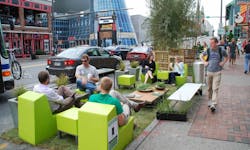Tactical urbanism: Why bigger isn’t always better in urban revitalization
Anyone who’s walked Chicago’s Millennium Park or New York’s High Line knows the awe-inspiring beauty of these celebrated public spaces is due not to their grand scale, but rather to their tiniest details and charming character—the manicured landscaping, quaint places of respite, tasteful art installations, lush gardens.
The lesson, say city planners, is that it doesn’t take vast acreage or hundreds of millions of dollars to create vibrant, modern public spaces that strengthen the social fabric of a city. In fact, a budding urban planning movement that is sprouting in cities across the globe proves that low-cost, small-scale, community-driven projects have the power to effect positive change.
There are a number of terms used to describe the movement—tactical urbanism, DIY urbanism, urban hacking, guerilla urbanism—and there are countless examples of successful projects and strategies, from street makeovers to pop-up parks to gardening initiatives to public art exhibits.
On the extreme side of the spectrum are projects like the 300-foot-long water slide installed down the middle of a street in Bristol, England, in May 2014 (www.BDCnetwork.com/WaterSlide). Then there’s Park(ing) Day, where citizens, artists, and activists in more than 160 cities collaborate to temporarily transform metered parking spaces into micro parks, gardens, and art exhibits.
San Francisco’s Pavement to Parks program teams city agencies with community groups to “hack” the city’s streets and public rights-of-way for community uses: sidewalk extensions, parklets, mini plazas, gardens, art walls, bike corrals, alleyway upgrades. The projects may be small, but their collective impact can be significant. Consider this: San Francisco’s streets and public rights-of-way make up 25% of the total land area and represent more space than all the public parks combined.
But not all micro urban remakes are created equal, as urban planner Mike Lydon writes in his four-volume guide to tactical urbanism (http://tacticalurbanismguide.com). For initiatives to serve as true change agents, they must: offer local solutions to local planning problems; develop social capital between citizens, community groups, and government; apply a deliberate, phased approach to instigating change; and offer a short-term, low-risk commitment, with the possibility for high reward. The goal, writes Lydon, is to foster long-term change through high-impact, temporary measures. “Long-term change often starts with the process of trying something small,” he writes.
Speaking of tactical urbanism, BD+C is proud to be partnering this year with Baltimore nonprofit Parks & People Foundation and USGBC National—along with building product manufacturers and a team of architects and contractors from Ziger/Snead Architects and Modular Genius—to build an uber-green training center for Parks & People. Located steps from the organization’s shiny, new LEED Platinum-registered headquarters in Baltimore’s historic Druid Hill Park, the 630-sf Growing Green Center will serve a critical role in Parks & People’s efforts to connect with and train local residents, students, and community groups on how to remake their streets and neighborhoods through landscaping, gardening, and urban infrastructure projects.
The Growing Green Center will be on display at Greenbuild 2015, Washington, D.C., Nov. 18-20, as part of BD+C’s GreenZone exhibit. At the conclusion of the conference, the structure will be trucked 39 miles to Baltimore, where it will become a permanent fixture at Druid Hill Park.

